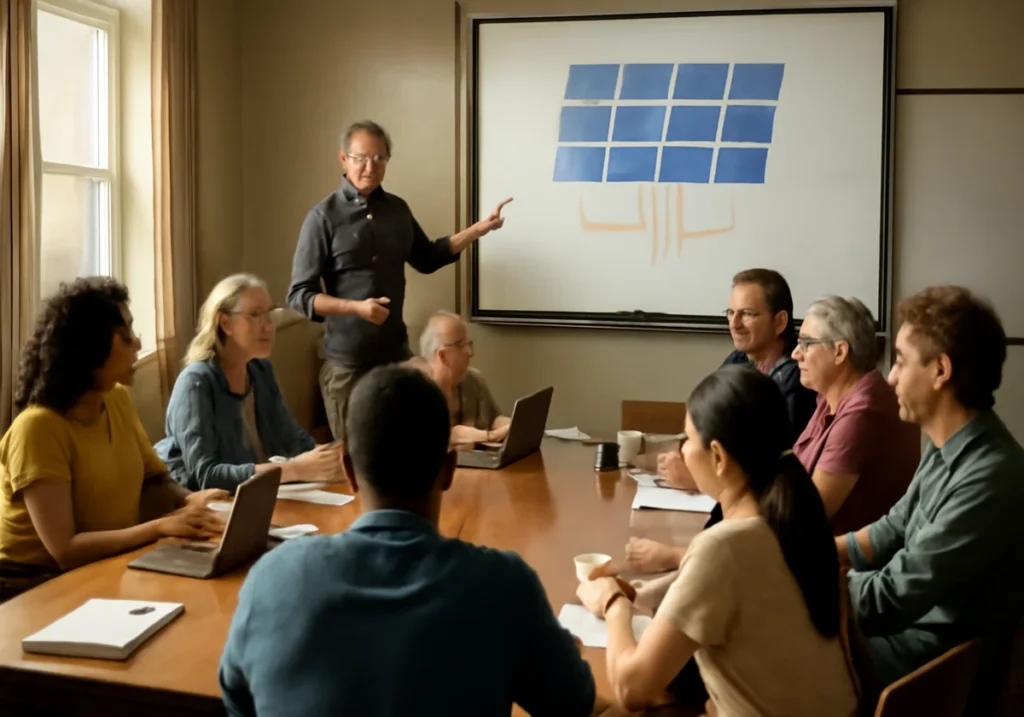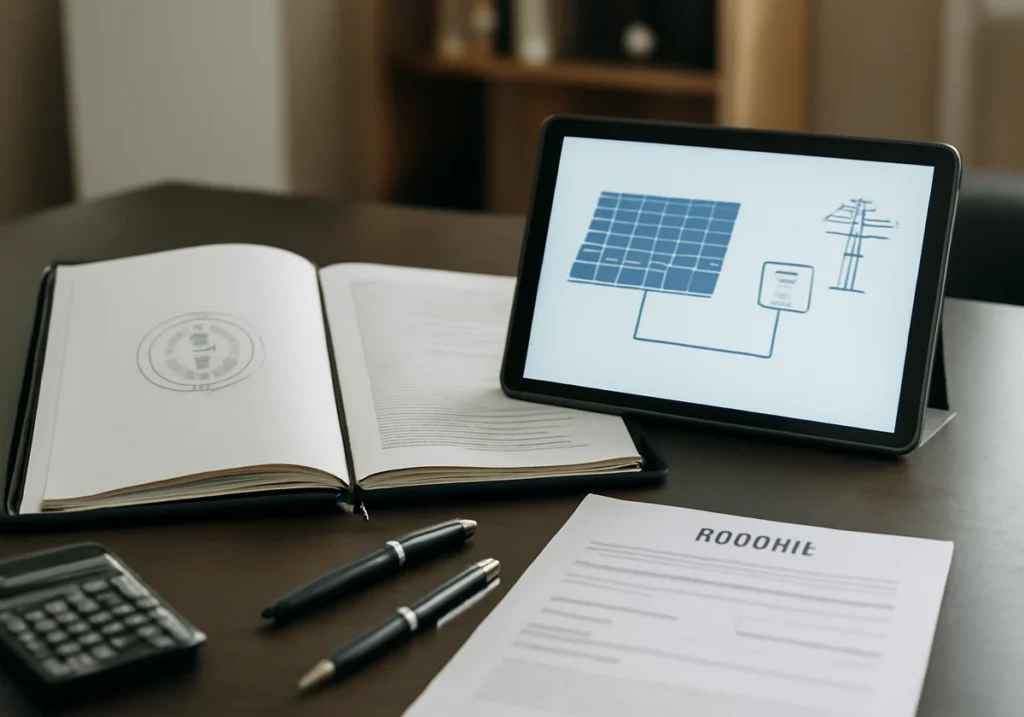Usually, neighbours of a solar co-op share clean power by contributing money together to build a local solar setup, then each member gets energy credits based on what they paid in. Sounds too good to be true, right?
However, as a sustainability hub focused on making eco-friendly solutions accessible, we see people stuck because they rent, face high costs, or lack the right roof space.
But community solar works around these issues completely, so anyone can access clean power regardless of their living situation.
In this article, we’ll share a practical roadmap for accessing shared solar power. You’ll learn:
- How co-operatives distribute clean energy among local members
- Who gains the most from community solar arrangements
- Subscription models vs. buying ownership shares
- Steps for launching your neighbourhood solar project
- What your electricity bill looks like with shared solar credits
Want to join the clean energy movement without the hassle of rooftop panels? Let’s get started.
Structure and Renewable Energy Principles of The Co-operative Model
Community solar co-ops follow a simple principle: many people share the cost and benefits of one large solar installation. The model removes traditional barriers like roof suitability or property ownership. And everyone wins when neighbours work together to generate power for their local area.
Before we explore the benefits, let’s break down exactly what community solar means and how the co-op structure shares energy among members.
What is a Community Solar Project?
A community solar project is a shared solar array owned or leased by multiple households in the same area. It is often called a solar farm or solar garden. The system works when members subscribe to a portion and get bill credits for the renewable energy their share produces.
The best part about it is that it’s a local way to fight climate change and boost solar power without putting panels on your home. The solar array sits on a shared site, like unused land or a large rooftop, and feeds clean electricity directly into the local grid.
Democratic Governance: How Co-ops Share Energy

The co-op structure allows members to collectively own and manage solar systems while splitting both costs and benefits fairly. Each member typically votes on major decisions, from choosing the solar installer to setting membership fees.
Also, the share of the energy produced matches the investment level. If you own 2% of the system, you receive 2% of the energy credits (yeah, it’s that simple). Besides, the co-op handles all maintenance and grid connection details, so you don’t need to install solar panels or manage technical issues yourself.
In our experience, most members appreciate the hands-off approach since the co-op takes care of everything while they simply enjoy lower bills.
Now that you understand how the co-operative structure works, we’ll explore who benefits most from this model and why it’s important for social equity.
Social Equity: Expanding Access Beyond Rooftop Solar
A solar co-op removes the old barriers that keep certain groups from using the energy. Homeowners without suitable roofs, renters who can’t install panels, and people with limited budgets all get equal access. Since the solar array sits on shared land instead of individual roofs, everyone can join and benefit together.
Here’s how the co-operative model fights social inequality:
Solving the Renter and Apartment Challenge
Research from Macquarie University shows that over 90% of Australian renters lack direct access to solar panels. That’s why a shared system is a win for renters or people in shared buildings who can’t physically install solar panels but still want access to renewable energy.
Even if you move to a new flat nearby, your membership in the project usually just moves with you. No more awkward conversations with landlords about taking panels down or leaving behind your investment.
Community Wealth and Job Creation
Can a local solar array also serve as a source of local jobs and money growth? Yes, it can, and here’s how.
The growth of local community solar projects keeps money in the area while helping local solar installers and tradespeople. Installation work, ongoing repairs, and project management all create jobs that stay within the community.
Plus, when community members own shares in the solar co-op, the energy savings and extra money stay in local homes instead of going to big companies far away.
Once you see how the system opens doors for everyone, it’s time to understand the money side and what joining or starting a co-op actually costs.
Costs, Ownership, and Government Aid for Community Solar

Thinking about joining a community solar co-op and what financial help is available? We understand the main worry for most people is whether they can afford to participate. But don’t worry, we’re here to help.
In this section, we’ll share the two main ways to join a co-op and the government programs that make it more affordable.
Investment Models: Subscription vs. Buying a Share
The easiest path is the subscription model, where you pay a small monthly fee and get a discount on the solar energy credits. But if you want a better financial reward, you can buy a portion of the project outright and own the share permanently. This option means any excess energy produced can earn feed-in tariff payments that go directly to you.
However, the right decision depends on your budget, how long you plan to stay in the area, and whether you want steady savings or a stronger return over time. Your solar installer can walk you through both options and help you see which one fits best.
Maximising Returns with Incentives
Policies from the Australian Government or state programs like those in New South Wales can provide grants to boost local renewable energy projects. For example, the Community Solar Banks program offers up to 50% grant funding and zero-interest loans to help co-ops get started.
Even members can earn extra money by selling solar renewable energy credits (SRECs), which reward participants for each unit of power their share generates. So your solar share keeps earning even when you’re not thinking about it.
How to Develop a Community Solar Installation
To develop your own community solar project, you need the right people, the right location, and the proper legal setup. The process takes time and planning, but thousands of communities across Australia have already done it successfully.
Follow these steps to bring shared energy to your neighbourhood:
Site Selection and Community Engagement
The process begins with gathering dedicated neighbours and finding a commercially viable spot for the new solar array. You’ll need enough space with good sun exposure and access to existing power lines.
These steps help build a strong foundation:
- Build a Core Team: First, you need a team of people who are passionate about community solar to recruit other members, handle planning tasks, and drive strong community engagement.
- Find the Right Location: Secure the land through purchase, lease, or partnership with local councils or businesses willing to host the array.
- Communicate Openly: From the start, keep the community in the loop. This builds trust and helps more people understand how they can participate and benefit.
We recommend hosting regular information sessions where neighbours can ask questions and voice concerns. Clear communication early on prevents misunderstandings later and keeps everyone excited about the project.
Legal and Technical Requirements for Go-Live

Your community solar project needs a formal structure (like a co-operative) to legally manage the energy sharing among members. This protects everyone’s investment and ensures fair distribution of benefits.
Here are the main steps:
- Figure out the financial blueprint (system costs and pricing) that covers installation and ongoing expenses
- Set up the legal entity and write the rules for preventing disputes among members
- Get permission to connect the array to the utility company’s system
All these requirements might sound overwhelming, but solar installers and co-op advisers can guide you through each stage.
Next, you’ll get to learn how your community solar share connects to the grid and lowers your electricity bill.
The Electricity Grid Interaction and Billing Process
Your community solar share connects to the local power network and affects your monthly bills in a direct, measurable way. It works in this way: the electricity grid receives electricity from the co-op’s panels, and the utility company credits you based on the ownership percentage.
Here’s how this translates to savings and grid benefits:
How Your Share Translates to a Lower Electricity Bill
Your share can lead to a lower electricity bill if the energy generated from your portion offsets what you normally draw from the electricity grid. The utility company tracks how much electricity the share produces each month and applies credits to the account.
For example, if ownership sits at 2% of a 100kW system, credits come in at 2% of all the electricity generated. These credits reduce the bill by offsetting the cost of power drawn from the grid.
Pro Tip: Check bills during the summer months when production peaks to see the maximum savings potential.
Grid Stability and Maximising Share Energy
Distributing power generation across numerous community projects makes the entire electricity grid more stable and reliable. So when a large plant has an issue, the grid is less likely to fail because power comes from many smaller sources.
Also, some co-ops install batteries to store excess energy for evening use, which helps members avoid higher electricity prices during peak hours.
Meanwhile, virtual net metering tracks how members share energy credits, ensuring everyone gets their fair portion regardless of where they live. The system keeps tabs on everything, so you don’t have to hire a mathematician.
Your Path to Shared Clean Power Starts Today
Community solar systems solve the renewable energy access problem that has kept renters, apartment dwellers, and budget-conscious households locked out for years. The barriers of high costs, unsuitable roofs, and rental agreements no longer stand in the way when neighbours pool resources and share the benefits.
We’ve covered how co-ops work, who benefits most, investment options, development steps, and how your share lowers bills. These pathways exist right now in communities across Australia.
Visit Eco4theWorld to explore more ways you can join the renewable energy movement and make sustainability part of your everyday life.
